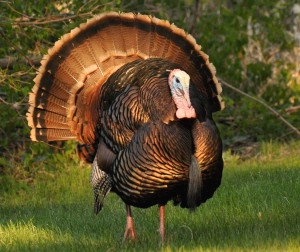Photography courtesy of Lowell Washburn, all rights reserved.
IOWA TURKEY RECOVERY IS CONSERVATION LANDMARK
“Now a deer thinks that every tall man is a stump. But the wild turkey thinks that every stump is a tall man. Be prepared. That’s just how nervous, wary, and suspicious a bird you hunters will be dealing with,” Iowa Wildlife Biologist, Rich Bishop addressing a capacity audience during a turkey hunting clinic held at the Mason City Public Library on April 10, 1979.
Mc GREGOR, IOWA—The scene was surreal. Ten minutes into the spring hunting season, and my Iowa turkey tag was already filled. A recently deceased, 22-pound gobbler lay sprawled at the opposite side of the two-track logging road; the feathered end of a cedar arrow still protruding from beneath its wing. Meanwhile, at the mere distance of 20 feet, a group of ten jakes and two full-fan toms remained assembled at my decoy. Milling in circles, the agitated flock continued to vigorously spar, strut, peck and gobble. It was an amazing sight.
The territory felt like home. I had, in fact, been prowling this same woodland ever since hunting partners Ed Kotz, Steve Schutte and I first began pursuing wild turkeys back in the late 1970s. I was sitting less than 50 yards from a spot that was once famous for its “sawdust track” – the location where alongside the stump and wood chips of a recently felled oak, the clearly stamped print of a wild gobbler had been clearly preserved in the logging trail’s slick surface.
Turkey hunting was brand new to Iowa and gobblers were scarce. But that single track offered proof positive that the elusive birds did actually exist – or at least occasionally pass through – the area. On at least two occasions, I had walked over a quarter mile out of my way for one more glimpse of that spectacular impression. Genuine turkey sign was hard to come by. If a hunter was fortunate enough to encounter a cast off turkey feather, for example, he would carefully collect the specimen and take it back to camp to be shared during fireside sessions of Show & Tell. That’s how sparse bird populations were back then. To imagine that a person could one day attempt to hunt wild turkeys with bow and arrow, actually bag one, and then watch as an additional dozen birds displayed and gobbled within 20 feet would have been – well, it would have been absolutely unthinkable.
Most contemporary hunters are aware that wild turkeys were historically abundant in Iowa, disappeared as the state was settled, and have been restored during modern times. Fewer are aware of what it actually took to return Iowa’s only species of “feathered big game” to rural landscapes. Iowa’s turkey restoration wasn’t cheap, wasn’t easy, and it did not happen by accident.
Iowa’s resoundingly successful turkey recovery was largely spearheaded by Iowa Wildlife Biologists, Rich Bishop and Terry Little. More than anyone, they deserve credit and recognition for returning the wild turkey to Iowa. Although turkey hunting had remained a time honored tradition across much of America’s Deep South, ties to the sport were long vanished from Iowa when the Conservation Commission [now DNR] first began successful recovery efforts during the late 1960s and early 1970s. Since the sport was still unknown here, it took no small amount of persuasion to bring key players on board. Initial recovery efforts were funded by Pittman-Robertson; a conservation trust that distributes revenues received from excise taxes paid on the purchase of guns and ammunition.
Since Bishop and Little were among the miniscule minority of those who had actually hunted turkeys in the South, they quickly became the state’s leading authorities on the sport. In addition to securing wild trapped turkeys for release in Iowa, they also became the bird’s foremost public ambassadors; organizing and facilitating statewide seminars designed to educate hunters on turkey biology and management and to communicate basic techniques surrounding the outdoors’ most challenging hunt. Interest was high, with crowds often exceeding fire code capacities.
During the early years of turkey hunting, recreational opportunities were much different than today. Hunting was restricted to three designated zones —– Stephen’s and Lucas State Forests in the south and the Yellow River Forest area in extreme northeastern Iowa. Turkey seasons were divided into just two segments which ran for a combined total of 16 days. Hunting was only allowed until noon. The use of decoys was illegal and manufactures offered little in the way of specialized turkey gear. Back then, a hunter could only take one turkey per season. The state issued around 300 licenses [by drawing] annually, and hunters bagged around 100 birds each spring.
During the late 1970s, it was not unusual for otherwise experienced hunters to literally spend several seasons in the turkey woods before finally getting a shot at a tom. Anyone who even saw a gobbler — at any distance — was considered fortunate. Many hunters never really expected to bag a genuine Timber Ghost for themselves — ever — but the idea that it somehow could happen was enough to keep enthusiasts standing in line.
By the mid-1980s, the pendulum had swung. Turkey populations were increasing to the point that the Conservation Commission had begun trapping and exporting birds to other states embarking on recoveries of their own. A total of 7,500 homegrown wild turkeys were traded for river otters, ruffed grouse, sharp-tailed grouse and prairie chickens for release in Iowa. Iowa turkeys were sold to other state agencies for $500 per bird, netting $3.2 million for additional acquisition of public forest lands.
Today, Iowa turkey hunting has flourished beyond all expectation. Current opportunities include a special youth season and four-part regular season that runs for a combined 44 days. Hunting is allowed statewide and shooting hours run from one half hour before sunrise to sunset. Around 50,000 licenses are issued annually, and hunters bag 11,000 to 12,000 gobblers each spring. Additional fall hunting seasons are also allowed across the state. Hunters capitalizing on all options can harvest up to four wild turkeys annually.
The restoration of the magnificent wild turkey to Iowa woodlands remains a hallmark achievement. No one would have dared believe just how successful or recreationally important the turkey recovery project would one day become. But with a combination of visionary leadership, hard work, sound wildlife management and hunter dollars, it happened just the same.
Although modern-day turkey populations have increased dramatically, the bird remains as elusive and challenging as ever. During the past nine years, less than one in four Iowa hunters were successful in bagging a spring turkey. Here’s one final nugget of woodland lore gleaned from that 1979 turkey hunting clinic held in Mason City:
“Their eyesight is keen. Their vision extraordinary. If they could smell, you’d never kill one,” Rich Bishop 



 Tom Cope
Tom Cope Sue Wilkinson
Sue Wilkinson Susan Judkins Josten
Susan Judkins Josten Rudi Roeslein
Rudi Roeslein Elyssa McFarland
Elyssa McFarland Mark Langgin
Mark Langgin Adam Janke
Adam Janke Joe Henry
Joe Henry Kristin Ashenbrenner
Kristin Ashenbrenner Joe Wilkinson
Joe Wilkinson Dr. Tammy Mildenstein
Dr. Tammy Mildenstein Sean McMahon
Sean McMahon